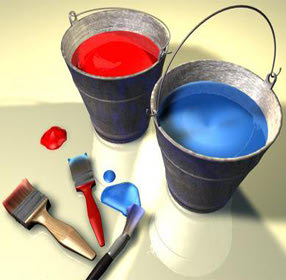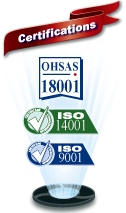Water-soluble varnishes and paints “EMEX”: Application
“Emex” Water-soluble Varnishes and Paints; Preparation
This category includes all the rough coats, paints and polishers based on acrylic polymers which can be thinned with water.
The instructions contained by these pages have only informative purpose. For detailed instructions please read the Data Sheet of the product or ask for special application instructions for each product, from the manufacturer.
The preparation of both the product and the surfaces represents a necessary to achieve maximum performance in application of any kind of paint. Therefore:
- The product is to be adjusted to the application temperature 24 hours before the application itself.
- Before opening the cover remove the dust or any other residual materials.
- The product is to be mixed in its original packing, using a mechanical mixer in order to disperse any potential deposits.
- Before use, filter the product (except “Emex AQ-Bar” Waterproof Paint, “Emex” Antiphon Paint, “Emex” Flame Retardant Thermoforming Paint, “Emex Mineral Protect” Concrete Varnishes, “Emex” Joint Varnishes.
- According to the application type the thinning is done by adding water.
- Do not mix the product with other types of products, even if these products are compatible, without the producer’s permission.
Application conditions:
- The optimum application temperature for the product: 5 - 30°C.
- The product temperature: 5 - 30°C.
- The support temperature: 5 - 40°C.
- Approximate environment moisture max. 65%.
- The support temperature will be at least 3°C above the dew point to avoid the moisture condensation on the support, which could decrease the adherence, luster or could cause blisters.
It is mandatory to check the Data Sheet of the products to obtain optimum results.
Preparation for Coating Metal Surfaces
The preparation for coating metal surfaces includes two stages: the primary preparation, applicable mostly to new surface which consists of:
- Removal of deposits, mud traces, dust, grease or any other contaminants.
- Surface degreasing – this should be done using alkaline substances which are more efficient, but it can also be done with thinner or varnish remover although this method is more expensive and shows a higher degree of risk both for application and health.
- Preparation of shuts and weld edges by removing the as drops and ashing, etc.
- Removal of soluble salts which is usually made by using water under pressure.
and the secondary preparation, which includes the removal of old paint, rust or scoria and creation of anchor points for high adherence on the support by:
- Abrasive cleaning Sa Degree 2 ½ (according to ISO 8501/1-88) or 2 (according to STAS 10166/1-77) fallowed by dust cleaning and grease removal.
- Rust removal when necessary, by using the “Emex Rust Stop” Rust Removal Solution (followed by washing with water) and old paint removal by using the “Emex CM Cleaner” Varnish Remover Solution or the “Emex PC Eco” Ecological Varnish Remover.
- Flame cleaning, applicable only in the case of the existence of very old protective coats, followed by roughing, cleaning and washing.
- It is mandatory to remove completely damaged layers of old paint. Those in good condition will only be polished for roughing, case which enables you to test if the paint matches.
One will always consider the application of “Emex AQ Eco” Anticorrosive Base Coat Water Soluble, or any other anticorrosive base coat matching the final layer of paint, both for the protection of the metallic surface and against corrosion and also for the adherence of the next coat.
 We do NOT recommend alkyd systems for the zinced surfaces, which will allow only Industrial Paints, recommended by the producer.
We do NOT recommend alkyd systems for the zinced surfaces, which will allow only Industrial Paints, recommended by the producer.
Preparation for coating wooden surfaces
The preparation for coating wooden surfaces requires a high degree of attention. The surface has to be perfectly dry and clean before applying the paint, without dust or any other contaminants.
Choosing a correct painting system will prolong the life of the painted wooden surface also ensuring a nice aspect.
- The surfaces are cleaned to remove dirt, resin drops and potential grease trails embedded in the fibers.
- Take into account that the wood humidity has to be of maximum 12% for the deciduous trees and 14% for the coniferous trees.
- If there are previous protections in good condition, use thinner to degrease, polish the wet surface using abrasive paper, dry it and clean any traces of dust.
- Old wasted paint or the ones that lack adherence will be completely removed through the use of “Emex CM Cleaner” Varnish Remover Solution or the “Emex PC Eco” Ecological Varnish Remover.
- Old layers can be removed by polishing with mechanical brushes or by burning.
- Every type of old coating removal operation will be followed by polishing.
- The support will be polished using abrasive paper with granulation of 180-220 (both for the new wood and for the old surfaces) across the fibers and will be dust cleaned by blowing compressed air.
- Before applying the rough coat apply a mold inhibitor such as “Emex” Forte Sanitizer, or use of anti-bacterial substances.
- Surfaces with imperfections (cracks, bumps, etc.) are to be leveled with appropriate lute. After it has dried (10-20 min.) the lute is burnished and the surface is dust cleaned.
- Considering that the wood has a generally porous surface, apply a soaking rough coat and/or equalization.
- Before applying the paint apply a rough coat for wood or a primer made by the paint itself, thinned approx. 30% with water.
- Lacquers are generally applied in 3 layers to obtain the luster, aspect and special presentation. Generally these require grinding between layers.
It is unadvisable the use of flax oil for wood impregnation because on the one hand it quickly degrades over time but on the other hand it creates an appropriate environment for the spur and growth of bacteria.
Preparation for Painting Concrete Surfaces
Applying the product on the support concrete surface, masonry, lime and cement plaster, plasters and lime or plaster stucco, old or new plasters based on binding materials, gypsum boards, absorbing mineral conglomerates of any kind, old organic or mineral masonry, dry, compact and absorbing, etc. will be done only after the necessary preparation due to the fact that this stage has a decisive influence over the quality and durability of the coating. Therefore:
- The concrete or new plasters (including repairs) require minimum 28 days for hardening and drying before application; if these conditions are not met the resistance of the product will be damaged in time and also determines exfoliation and blisters
- The plastered surfaces are to be verified by knocking before applying the product; if they prove to be inappropriate (sound empty) the plaster will be completely removed until reaching the base and the surfaces will be reshaped with binder of the same class as the initial one.
- Before applying the product repair the empty spots or other imperfections.
- If there are previous well preserved protections, use thinner to degrease them, polish the surface with abrasive paper, dry and clean the dust.
- Old wasted paint or the ones that lack adherence will be completely removed through the use of “Emex CM Cleaner” Varnish Remover Solution or the “Emex PC Eco” Ecological Varnish Remover.
- Old layers can be removed by polishing with mechanical brushes or by burning.
- Every type of old coating removal operation will be followed by polishing.
- Mold affected areas will be cleaned and impregnated with special anti-mold solutions, cum ar fi “Emex” Forte Sanitizer.
- The surfaces which are to be covered in paint have to be cleaned and degreased, roughed and the resulting dust will be removed with soft brushes or blown by compressed air.
- The surfaces have to be smooth, plain and dry.
- Before applying the paint apply a rough coat for wood or a primer made by the paint itself, thinned approx. 30% with water.
Metallic inclusions will be necessarily covered with “Emex AQ Eco” Anticorrosive Base Coat Water Soluble, or the alt grund compatibil, la recomandarea producatorului.
These instructions especially refer to water soluble Varnishes, Paints and Base Coat.

![]()
Paint for tiles|Fireproof paint|Acrylic paint for metal|Sound-proofing paint|Universal acrylic paint|Furniture acrylic paint|Hydrophobization varnish
Acrylic varnish for stone|Hidrophob varnish|Waterproof paint|Hydro-soluble Base Coat|Varnish joint protection|Adhesive for constructions|Premium emulsion paint
Anti mold emulsion paint|Silicone interior emulsion|Emulsion optical effect|Reflective emulsion paint|Anti-mold solution|Chlorinated rubber paint|Fireproof paint
Yachts paint|Hammer blow|Emex dual protect|Silver bronze enamel|Ecologic Paint remover|Solution against rust
- PRODUCTS
- Washable Paint
- Decorative Enamels
- Decorative Plaster
- Industrial Paints
- Hydrosoluble Products
- Founded Paving
- Paving & Traffic Paints
- Base Coats & Water Primers
- Anticorrosive Base Coats
- APPLICATION
- Washable Paint
- Decorative Paints
- Decorative Plaster
- Bicomponent Paints
- Bicomponent Paving
- Polyurethane Membrane
- Water-Soluble Paints

WE WILL CONTACT YOU !
 If we send an SMS to 0760-698.506, with product you are looking (REGULAR CHARGE).
If we send an SMS to 0760-698.506, with product you are looking (REGULAR CHARGE).
Or you can contact us at:
 For eMail: Click here...
For eMail: Click here...021-457.0646; 021-457.0638; 021-457.1693
Mobile:
0724-509552; 0724-577075; 0728-941507
Visit page...
Visit page...
Visit page...
Visit page...
Tags: Water-based paints, Preparation for painting, How to paint, Paint preparation, Preparation surfaces










